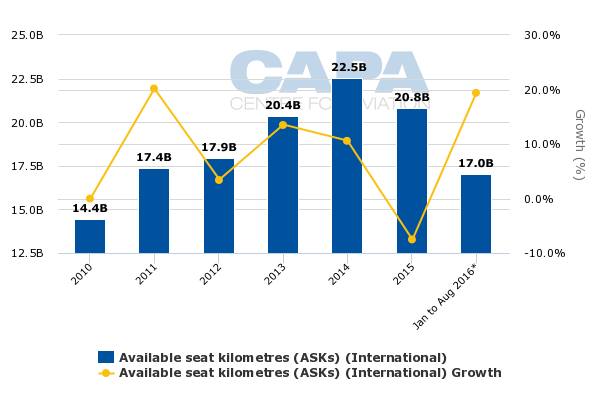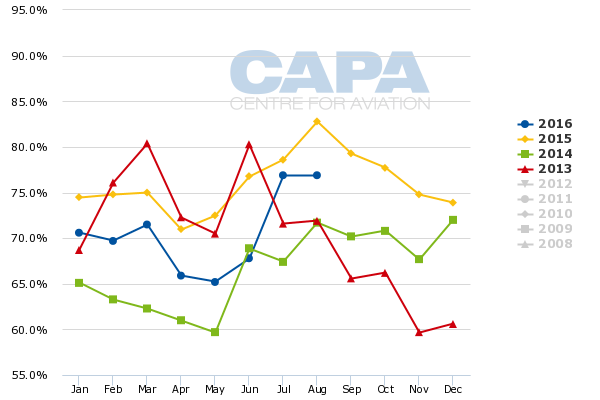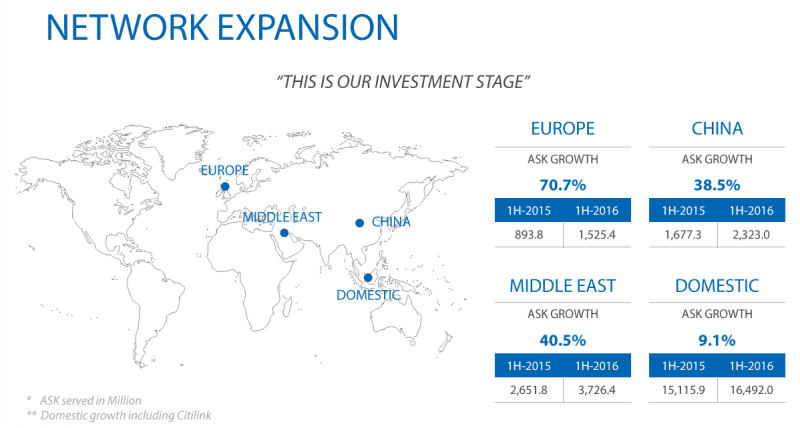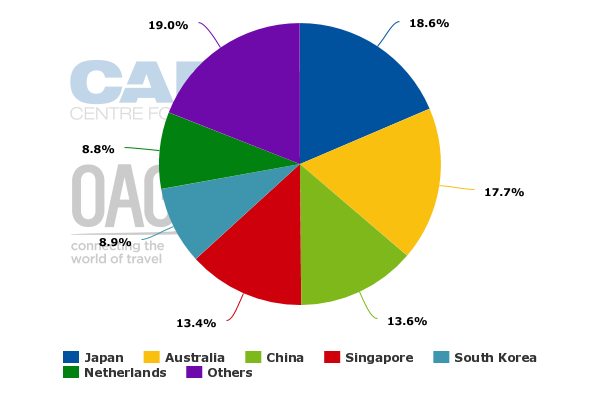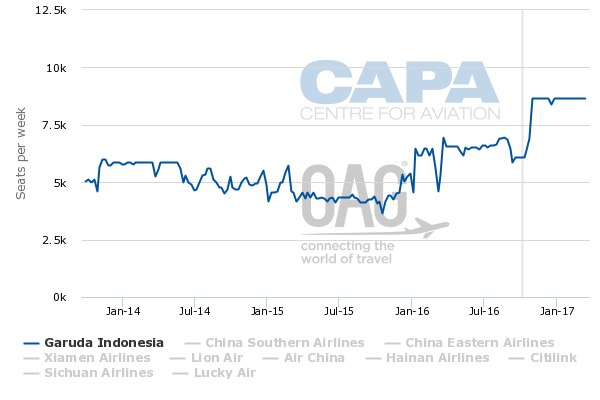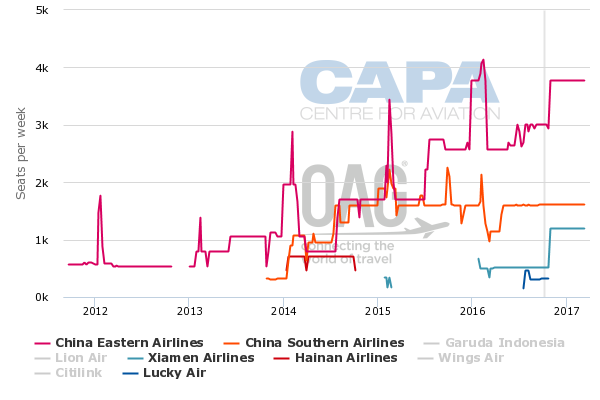Garuda Indonesia international outlook Part 1: further expansion despite weak 1H2016 results
Garuda Indonesia is planning further international expansion in 4Q2016 and 2017, despite a recent lacklustre performance in the international market. Garuda is adding capacity to China in 4Q2016 and aiming to launch services to the US in 2017.
Garuda's international load factor was only 70% through the first eight months of 2016 as the airline struggled to fill additional seats generated by an 18% increase in ASKs. International yields have also declined as Garuda swung back into the red in 1H2016.
The long haul network has particularly struggled, driving the drop in profitability. However Garuda is keen to continue strategic expansion.
Garuda's international ASKs are up nearly 20% compared to 2015
Garuda currently serves 17 international destinations, including 14 in Asia Pacific, two in Europe and one in the Middle East (based on OAG schedules for the week commencing 3-Oct-2016).
Garuda has resumed international expansion in 2016 after restructuring its international network in 2H2014 and early 2015, which led to an 8% drop in international ASKs in 2015.
See related report: Garuda Indonesia Part 1: Strategic international expansion and an ambitious hub plan for Jakarta
Garuda's international ASKs were up 19.4% through the first eight months of 2016. The additional capacity was driven primarily by the launch of flights to London Heathrow, three new routes to China from Bali and additional capacity to Saudi Arabia.
Garuda international ASKs and year-over-year growth: 2010 to 8M2016
However, Garuda has struggled to fill the additional capacity. International RPKs were up 11.1% in the eight-month period, resulting in a 5.6ppt drop in load factor to 70.3%.
In Aug-2016, the latest month Garuda has reported operational figures for, international ASKs were up 18% and RPKs were up 10%. Garuda's international load factor slipped 5.9ppts in Aug-2016 to 76.9%.
Rapid international expansion comes at the expense of yields and profitability
The rapid international expansion has also impacted Garuda's yields and profitability. Garuda's international passenger yield fell 9% year-over-year in the first eight months of 2016, including a 3% decline in Aug-2016.
The Garuda Indonesia Group incurred an operating loss of USD38 million in 1H2016, compared to an operating profit of USD78 million in 1H2016. The group incurred a net loss of USD63 million, compared to a net profit of USD29 million in 1H2015.
Revenues were down 4% to USD1.764 billion despite the increased capacity. Revenues from scheduled services were down 3% in 1H2016 to USD1.564 billion.
Garuda Indonesia Group financial highlights: 1H2016 vs 1H2015
A challenging international market was the main contributor to the swing in profitability. However domestic market conditions have also become difficult, impacting both the parent airline and Citilink. The LCC subsidiary, which only operates domestically, was profitable for the first time in its history in 2015 but was back in the red in 1H2016.
International loads are still above 2014 levels
This is not the first time Garuda has struggled when attempting to accelerate international expansion.
In 1H2014 Garuda posted an operating loss of USD234 million and a net loss of USD212 million, driven by a dismal performance in the international market following a period of overambitious expansion.
See related report: Garuda Indonesia will slow international expansion and defer aircraft following a dismal 1H2014
Garuda's international ASKs were up 14% in 2013 and 15% in 1H2014. Its international load factor slipped to only 63% in 1H2014; the international load factor improved to 74.1% in 1H2015 as capacity was cut, but slipped back to 68.4% in 1H2016 as expansion resumed.
In 2016 Garuda's international monthly load factor has generally been above 2014 levels but below 2015 levels. This indicates that the current situation is challenging but not quite as dire as 2H2013 and 1H2014, when the load factor was even lower and Garuda had steeper losses (due partially to higher fuel prices).
Garuda Indonesia monthly international load factor: Jan-2013 to Aug-2016
China, UK and Saudi Arabia drive the most recent capacity increase
In 1H2014 Garuda's international load factor, yield and profitability were impacted by capacity increases to Europe, Australia and Japan. In 1H2016 the capacity increases were focused again on Europe, as well as to China and Saudi Arabia.
The Europe region recorded the highest ASK growth in 1H2016, at 71%, but on a relatively low base. Garuda launched flights to London Heathrow in Mar-2016, with five weekly flights on a Jakarta-Singapore-London-Jakarta routing.
Garuda operates nine weekly flights to Europe, including six to Amsterdam and three to London Heathrow using three-class 777-300ERs. Three of the Amsterdam flights and all of the London flights stop in Singapore on the outbound sector, but all of the fights returning to Jakarta operate nonstop. (Garuda operated 11 weekly flights to Europe in 2Q2016 and 3Q2016, but has reduced London from five to three weekly frequencies from late Sep-2016 to mid-Dec-2016.)
Middle East ASKs were up 41% in 1H2016 as Garuda expanded in the Saudi Arabia market, with new routes to Jeddah from secondary Indonesian cities and a new seasonal service from Jakarta to Medina. (The Medina service is not operating in Oct-2016 and therefore Medina is not included among the current 17 international destinations.)
China has been another focus area, with ASKs up 39% in 1H2016. Across the rest of the Garuda international network, which accounts for over 70% of total international ASKs, capacity was slightly lower in 1H2016 compared to 1H2015.
Garuda Indonesia international expansion: 1H2016
Garuda has not been growing in Australia or Japan
Europe currently accounts for approximately 12% of Garuda's ASKs but less than 4% of seats (based on schedules for week commencing 3-Oct-2016). The Middle East accounts for slightly over 2% of Garuda's ASKs, while China accounts for approximately 14%.
Regional flights within Southeast Asia currently account for 19% of Garuda's international ASKs but a 42% share of seats. Garuda has slightly increased capacity to Southeast Asia in 2016, driven by additional flights to Singapore.
Australia accounts for approximately 18% of Garuda's ASKs. North Asia flights excluding China account for the the remaining 35%, including approximately 19% for Japan, 9% for South Korea and 7% for Hong Kong.
Garuda has maintained relatively flat capacity to Australia since implementing reductions in early 2015 as part of its previous restructuring exercise. Garuda's Australia capacity was down slightly in 1H2016 due to the impact of reductions, including the suspension of Brisbane, that were implemented in Feb-2015.
Garuda also dropped Taiwan and cut capacity to Japan in 2014. Its Japan and South Korea capacity has been relatively flat over the last year.
Japan is still Garuda's single largest international market - based on ASKs - followed by Australia. On a seat basis Singapore is Garuda's single largest market, followed by Japan and Australia.
Garuda international capacity share (% of ASKs) by country: 3-Oct-2016 to 9-Oct-2016
Garuda focuses Asia-Pacific growth on China
In North Asia, Garuda has only increased capacity in 2016 in Hong Kong and mainland China.
Bali-Hong Kong, which is served daily, was upgauged from 737-800s to A330-300s in Mar-2016. Garuda continues to serve Jakarta-Hong Kong with two daily frequencies using a mix of narrowbody and widebody aircraft.
In early 2016 Garuda also launched flights from Bali to Beijing and Shanghai. Bali-Guangzhou was launched in late 2015.
Garuda currently operates six scheduled routes to mainland China - Bali to Beijing (four times weekly), Guangzhou (thrice weekly) and Shanghai (thrice weekly) as well as the longer-established routes of Jakarta to Beijing (three times weekly), Guangzhou (daily) and Shanghai (daily). All the Beijing and Shanghai flights are currently served with A330-300s, while the Guangzhou flights are currently served with 737-800s.
Garuda to grow China capacity by another 50% in 4Q2016
Garuda is upgrading Denpasar-Guangzhou to daily A330-300 service from the end of Oct-2016. At the same time it is also upgauging Bali to Beijing and Shanghai from A330-300s to two-class 777-300ERs, and adding a fourth weekly flight on Jakarta-Beijing.
The upcoming changes will result in almost a 50% further increase in Garuda capacity to China. Garuda's seat capacity to mainland China is already up approximately 50% year-on-year, driven by the launch of services from Bali to Beijing, Guangzhou and Shanghai.
Garuda weekly scheduled seat capacity to China (one-way seats per week): Sep-2013 to Mar-2017
The upgauging of its three Bali-China routes less than a year after they were launched indicates the routes have been successful, and that Garuda is experiencing strong demand from China - particularly for Bali.
Indonesia reported a 19% growth in Chinese visitor arrivals in 2015, to 1.2 million. The inbound market from China has been growing at a similarly rapid rate in 2016, driven primarily by Bali, which has emerged as a popular tourist destination for Chinese residents.
Garuda plans Bali-Chengdu service
Garuda is planning to launch scheduled services from Bali to Chengdu in early 2016. Bali-Chengdu has been one of several seasonal charter routes that Garuda has operated in 2016 in the Indonesia-China market (mainly from Bali).
Chengdu will be Garuda's fourth destination in mainland China and first secondary Chinese city. However, Garuda is considering several potential secondary destinations in China - most of which it has already tested out with charters.
Pursuing further expansion in the Bali-China market is sensible, given the surging demand. However, Garuda needs to be careful not to be overly ambitious with its Bali-China capacity as it is a highly competitive market, with seasonal fluctuations in demand.
Bali-China market has become very competitive
China Eastern, China Southern and Xiamen Airlines have also added capacity to Indonesia over the last year, while Chinese LCC Lucky Air has launched services to Bali. Chinese airlines have a competitive advantage as they have strong brands and distribution networks in China and can also easily adjust schedules to meet seasonal fluctuations.
Chinese airlines weekly scheduled capacity to Bali (one-way seats per week): Sep-2013 to Mar-2017
Other Indonesian airlines, including Lion Air, have also responded to rapid growth in the Bali-China market with new flights. So far most of these flights have been charters, but they are likely to be upgraded to scheduled services over the next year.
Total Bali-China capacity has doubled over the last year. There are opportunities for further growth, but there is also a risk of overcapacity.
Garuda prepared to invest in further long haul expansion - including US service in 2017
China expansion represents a much less risky proposition for Garuda than long haul expansion.
As CAPA has previously highlighted, Garuda has particularly struggled in the London market since launching Heathrow services, with load factors below 50% in the initial months. Garuda views the London route - along with the more mature but still unprofitable Amsterdam service - as long term strategic investments. (Amsterdam was upgraded to nonstop, and from A330s to 777s, in 2014, when a stopover in Abu Dhabi was dropped.)
Garuda's executive team is keen to continue with the strategic expansion of the long haul network, despite the losses that such expansion will bring, believing it needs to make such investments to improve its position over the long term. Garuda is therefore preparing to launch services to the US in 2017, and is also evaluating additional destinations in continental Europe.
In Part 2 of this report CAPA will examine Garuda's plans for the Americas and partnership options
